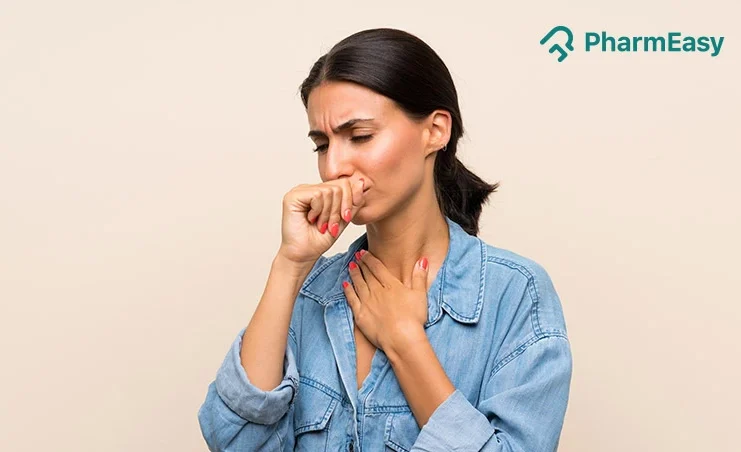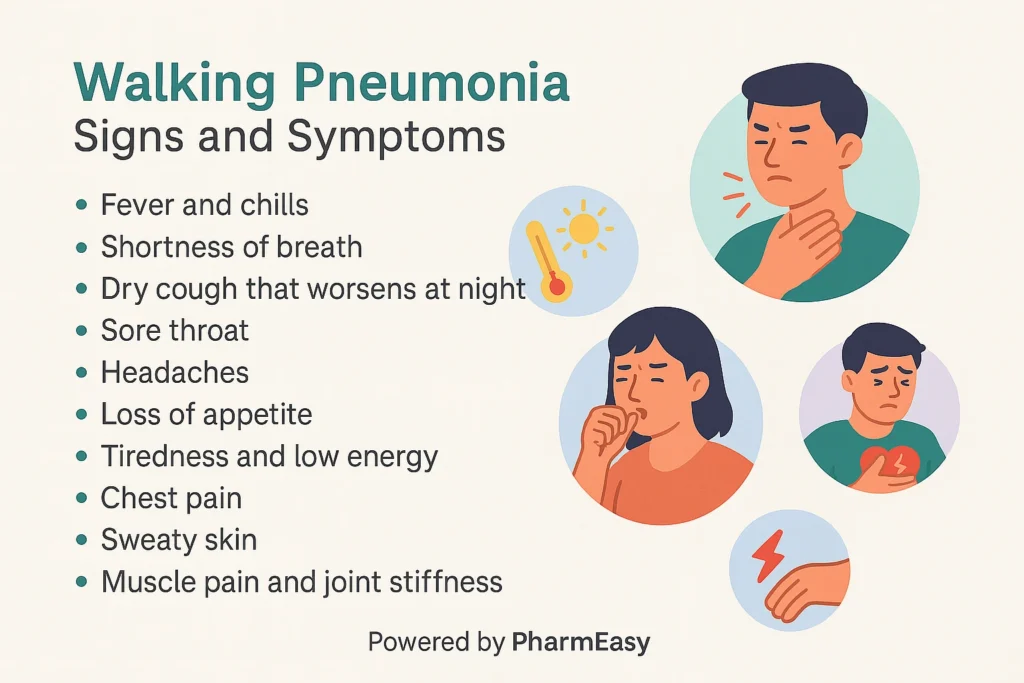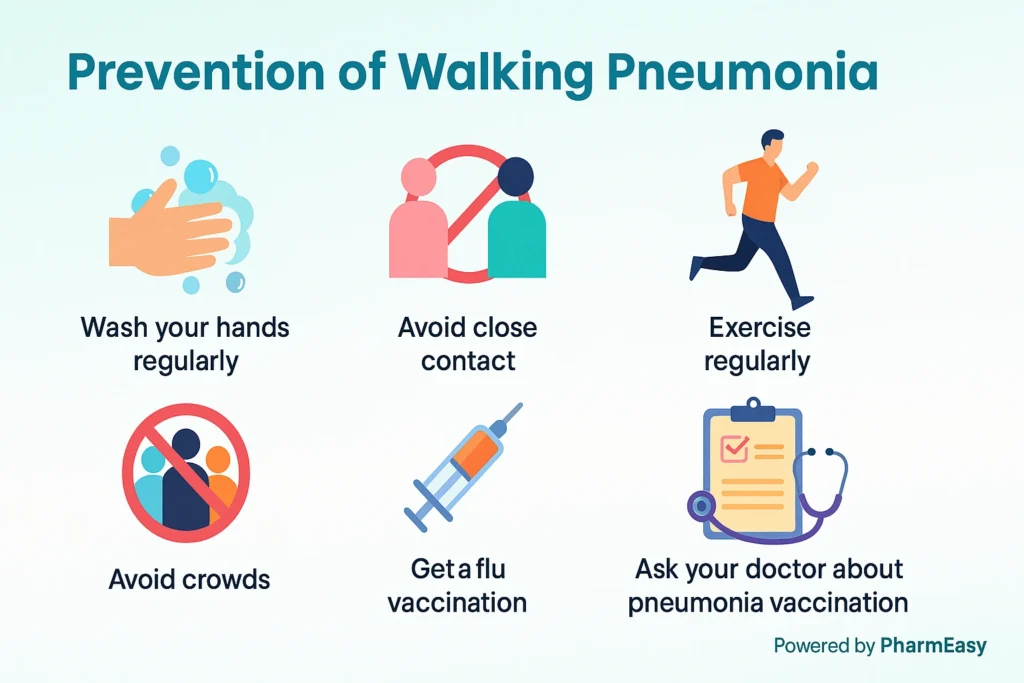Introduction
Are you wondering what is walking pneumonia? Walking pneumonia or atypical pneumonia is an infection of the lower respiratory tract1. This condition is generally a milder form of pneumonia where the patient may be well enough to walk around, that’s why it’s called “walking pneumonia2”.
This type of pneumonia is usually acquired outside of hospital or healthcare settings and caused by pathogens that are not commonly associated with pneumonia and not easily detectable by common staining and culture methods1. The most common organisms associated with walking pneumonia include the bacteria Mycoplasma pneumoniae, Chlamydia pneumoniae, or Legionella pneumoniae3.
Bacterial atypical pneumonia comprises around 15% of the total pneumonia cases acquired outside of hospital and healthcare settings4. Although, usually these infections are not very severe, the mortality of walking pneumonia among the elderly is 8.0%, while in younger, healthy individuals, the mortality is 0.5-2.0%5.
What Is Walking Pneumonia?
Walking Pneumonia, scientifically referred to as atypical pneumonia, is a milder form of lung infection, often caused by Mycoplasma pneumoniae, that generally does not require hospitalisation.
As this pneumonia usually has a mild course , most affected individuals can still continue their routine without any interruption to your daily activities and hence, this condition is commonly referred to as walking pneumonia2.
However, it is important to note that the severity of pneumonia can range from mild to life-threatening depending on factors such as age, the type of organism causing the infection, and when the walking pneumonia treatment is started1.
Causes of Walking Pneumonia
You may be wondering what causes walking pneumonia. Actually, walking or atypical pneumonia is caused by an invasion of bacteria (most commonly), and viruses or fungi (less commonly), that leads to inflammation of your air sacs or alveoli in your lungs1.
- Bacteria: Bacteria such as Mycoplasma pneumoniae, Chlamydia pneumoniae and Legionella pneumoniae are the most common causative organisms of atypical pneumonia3.
- Viruses: Viruses such as the severe acute respiratory syndrome coronavirus 2 may cause atypical pneumonia3.
- Fungi: Rarely, pneumonia may be caused by fungi, especially in individuals with a weak immune system6.
Walking pneumonia is typically acquired from the community (outside a hospital setting), most often by inhalation of respiratory secretions that contain the causative organism.
Types of Atypical Pneumonia
Based on what causes walking pneumonia, the different types of atypical pneumonia include:
- Mycoplasma pneumonia: This condition generally affects children, adolescents and young individuals (typically 5-15 years), but it can occur at any age7,8. In individuals, it can cause a range of symptoms, from mild respiratory tract infections to severe atypical pneumonia9.
- Chlamydia pneumonia: This condition can cause upper and lower respiratory tract infections causing symptoms such as headaches, tiredness, hoarseness of voice, fever, sore throat and cough that becomes worse over time10.
- Legionnaire’s disease: This condition generally affects middle age and older individuals. It is more often noticed in individuals with a weak immune system or chronic illness and in smokers7. This infection mainly spreads by inhalation or aspiration of contaminated water (For example: showers, hot tubs, etc) The symptoms noticed include fever, muscle pain, headaches, shortness of breath, diarrhoea and cough11.
- Q Fever: This condition is caused by the bacteria Coxiella burnetii which may present with symptoms such as fever, tiredness, muscle aches and chills. Q fever is often zoonotic (infection transmitted from animals to humans) and it is commonly noticed in individuals who work closely with animals or livestock. Individuals may get infected by inhaling dust contaminated with animal products and excreta such as faeces, urine and milk3,12.
- Psittacosis: Less commonly noticed, this condition generally affects individuals in close contact with pet birds and poultry and is caused by the bacteria, Chlamydophila psittaci (formerly Chlamydia psittaci) which is a zoonotic atypical pneumonia. Common symptoms of psittacosis include headaches, fever, chills, dry cough and muscle pain3,13.
Signs and Symptoms
Though walking pneumonia is a mild infection, it does not always mean that you may be asymptomatic or fully functional. The walking pneumonia symptoms are generally mild and mainly include1,7:
- Fever and chills
- Shortness of breath
- Dry cough that worsens at night
- Sore throat
- Headaches
- Loss of appetite
- Tiredness and low energy
- Chest pain
- Sweaty skin
- Muscle pain and joint stiffness
Less common signs of walking pneumonia that may be noticed in the different types of walking pneumonia include7:
- Mycoplasma pneumonia: Otitis media (Ear pain), cervical lymphadenopathy (lump in the neck), erythema multiforme (rashes), and conjunctivitis (eye pain and soreness)
- Legionella pneumonia: Diarrhoea, vomiting, blood in mucous
Risk Factors
General risk factors include7,14
- Age extremes (Younger children or elderly)
- A weakened immune system
- Chronic medical conditions such as diabetes, heart or lung disease, chronic liver disease, etc.
- Living in crowded settings
- Smoking
- Excessive alcohol consumption
You may pose an increased risk of developing specific types of atypical pneumonia if you are:
- A child, teenager or an adult under 40 years of age (Risk factor for Mycoplasma pneumonia). Although it can occur in older adults, it is less common7.
- Increased age, smoking, weak immune system, chronic lung disease and exposure to contaminated water (Risk factor for Legionella pneumonia)7 ,11.
- In close contact with infected birds and poultry or exposure to bird droppings and secretions increase your risk of Psittacosis infection. (Risk factor for Psittacosis)13.
Is walking pneumonia contagious?
Yes, it is contagious and walking pneumonia symptoms can spread from person to person. However, infections caused by Legionella pneumonia and Coxiella burnetii (Q fever) are not spread from person-to-person1.
The most common type of walking pneumonia caused by Mycoplasma pneumonia is highly contagious and spreads through infected droplets of affected individuals especially when they cough and sneeze. The disease spreads when you inhale these infected droplets15.
Hence, close proximity with an infected individual over an extended period of time causes the spread of infection. The symptoms are generally noticed two to three weeks post exposure to the causative agent (Mycoplasma pneumonia). However, it is important to note that you may be contagious before any symptoms appear and generally, once infected, the contagious period is around 10 days and may be longer, if not treated15.
How is walking pneumonia diagnosed?
Your doctor will be able to diagnose walking pneumonia with certain examinations and laboratory tests such as7:
- Chest X-ray: Your Chest X-ray may show patchy infiltrates which is a feature of atypical pneumonia. However, it cannot accurately distinguish between walking pneumonia and other pneumonias or respiratory conditions like bronchitis4.
- Blood Tests: Based on the severity of your condition, your doctor may recommend laboratory tests such as:
- Complete blood count
- Measurement of arterial blood gases: To check oxygen and carbon dioxide levels in blood (Used in cases where ventilatory failure or hypoxia is suspected)16.
- Other blood tests: To identify the specific bacteria causing your illness.
- Blood Cultures: To check for bacteria in the blood.
- Bronchoscopy (Tube with a camera is passed to your lungs): Only used when diagnosis is unclear, atypical presentations, or failure to respond to treatment.
- Swab of nose or throat: To identify any bacteria and viruses
- Sputum Culture: To identify specific bacteria causing your illness.
- Urine Test: To help in the diagnosis of Legionella pneumonia.
Based on these tests, your doctor will be able to accurately diagnose your condition and will suggest the appropriate walking pneumonia treatment.
Treatment
After a careful assessment of your condition, your doctor will be able to suggest the best walking pneumonia treatment suitable for you.
- Macrolide antibiotics: This is generally the first line of treatment to manage walking pneumonia. Macrolide antibiotics prescribed may include azithromycin and clarithromycin1.
- If resistance is suspected, fluoroquinolones (Eg: levofloxacin, moxifloxacin) and tetracyclines (Eg: doxycycline) may be used as alternative treatments1.
- The macrolide antibiotics may be combined with broad-spectrum medications including ceftriaxone, cefotaxime depending on the severity of your condition (particularly when both typical and atypical pathogens are suspected)1. If your condition is severe, your doctor may recommend antibiotics intravenously7.
- Over-the-counter medications: Non-Steroidal Anti-Inflammatory Drugs or NSAIDs (such as aspirin, ibuprofen, naproxen) and cough medication may be effective in managing symptoms such as fever and cough7. However, in children, aspirin is not recommended.
- It is important to get plenty of rest7.
- Drink lots of fluid. This will help to loosen your secretions and bring up the phlegm7.
Delayed treatment in individuals suffering from Legionella or weakened immune systems can worsen treatment outcomes. While delayed treatment may not always lead to severe disease in cases of Mycoplasma infections, early treatment is key for good recovery and prognosis1,11.
Prevention
To reduce your risk of infection, you can follow these steps2,7:
- Wash your hands regularly with warm water and soap.
- Avoid close contact with individuals who are sick and wear a mask to reduce your risk of infection.
- Exercise regularly and eat timely meals with a well-balanced diet.
- Ensure that you get a flu vaccination every year to reduce your chance of infection.
- If you have a weak immunity, it is recommended to avoid crowds.
- Consult your doctor about pneumonia vaccination. Your doctor may suggest that you get vaccinated for pneumococcal pneumonia as it can help protect against Streptococcus pneumoniae, which causes a type of pneumonia not associated with healthcare settings.
- To ensure good respiratory health, consult your doctor about DTaP/ Tdap Vaccination (Diptheria, tetanus and pertussis vaccine) as it helpful for your respiratory health.
By following these simple methods, you can avoid catching pneumonia especially if you are at high risk and protect your overall health2.
Also Read: Is Bronchitis Contagious? Causes, Transmission, Symptoms & Treatment
Living with Walking Pneumonia
While individuals with walking pneumonia may be able to carry on with routine activities, certain self-care and hygiene measures can aid in a faster recovery. These include2,7,17:
- Get adequate rest and sleep well.
- Pay attention to your diet; choose food that is healthy for your heart and stay hydrated.
- Quit smoking and avoid alcohol.
- Do light exercise. (You doctor can suggest the appropriate regimen)
- Practise deep breathing.
- Take medications as advised by your doctor.
- Keep a watch of your symptoms. If there is no improvement or there is worsening of symptoms even after taking antibiotics, contact your doctor immediately.
Remember, if you are walking around with pneumonia, it’s your responsibility to prevent its spread to others. Avoid any unnecessary contact with other individuals. Avoid going to public places and always cover your mouth while sneezing and coughing or wear a protective mask. Wash your hands with soap and water regularly. Following these simple measures can have a huge public health impact.
Also Read: Bacterial Pneumonia: What Is It, Causes, Symptoms & Treatment
When to See a Doctor
You should consult your doctor if you develop signs of walking pneumonia such as fever, shortness of breath, or cough. Your doctor will thoroughly assess your condition and will advise you on the best method to manage your condition.
You should also consult your doctor if you have been diagnosed with pneumonia and if your walking pneumonia symptoms get worse after an initial improvement7.
Also Read: Is Pneumonia Contagious? Causes, Transmission, Symptoms & Treatment
Conclusion
Walking pneumonia, or atypical pneumonia, is generally a mild respiratory infection commonly caused by atypical bacteria such as Mycoplasma pneumoniae, Chlamydia pneumoniae, and Legionella pneumoniae. While walking pneumonia symptoms are not very severe, it still requires proper medical care. With timely diagnosis, appropriate walking pneumonia treatment, and good hygiene, you can recover smoothly and avoid complications. Tips like handwashing, vaccinations, and avoiding smoking play a key role in reducing your risk and promoting your overall health.
Frequently Asked Questions (FAQs)
Can walking pneumonia recur after treatment?Although not very common, walking pneumonia can recur after treatment. The chances of recurrence are increased if the infection is not completely removed with antibiotics or if you face any antibiotic resistance1.
What are the complications of walking pneumonia? If not diagnosed and treated properly, complications may arise and may include brain and nervous system infections (such as meningitis, encephalitis), severe lung damage, haemolytic anaemia (a condition in which the body destroys its own red blood cells) and respiratory failure7.
Can walking pneumonia be detected on a regular physical exam? Walking pneumonia may not be detected on a routine physical exam alone and your doctor may require a chest X-ray or other laboratory tests to confirm the diagnosis7.
Can I exercise if I have pneumonia? Exercise may be beneficial in pneumonia. A study18 has shown lower mortality rate in elderly individuals having pneumonia who walk daily compared to individuals who did not walk or exercise in any other form. However, you doctor will guide you best if exercising or walking is suitable for you if you have pneumonia.
References
- Stamm DR, Stankewicz HA. Atypical Bacterial Pneumonia [Internet]. PubMed. Treasure Island (FL): StatPearls Publishing; 2020. Available from: https://www.ncbi.nlm.nih.gov/books/NBK532239/
- National Heart Lung and Blood Institute. What Is Walking Pneumonia? [Internet]. Lung.org. 2017. Available from: https://www.lung.org/blog/what-is-walking-pneumonia
- Miyashita N. Atypical pneumonia: Pathophysiology, diagnosis, and treatment. Respiratory Investigation [Internet]. 2021 Nov;60(1). Available from: https://pubmed.ncbi.nlm.nih.gov/34750083/
- Dueck NP, Epstein S, Franquet T, Moore CC, Bueno J. Atypical Pneumonia: Definition, Causes, and Imaging Features. RadioGraphics [Internet]. 2021 Apr 9;41(3):200131. Available from: https://pubs.rsna.org/doi/full/10.1148/rg.2021200131
- Bajantri B, Toolsie O, Venkatram S, Diaz-Fuentes G. Mycoplasma Pneumoniae Pneumonia: Walking Pneumonia Can Cripple the Susceptible. Journal of Clinical Medicine Research [Internet]. 2018 Dec 1;10(12):891–7. Available from: https://www.ncbi.nlm.nih.gov/pmc/articles/PMC6225856/
- What Is Pneumonia? [Internet]. NHLBI, NIH. 2022. Available from: https://www.nhlbi.nih.gov/health/pneumonia/
- Atypical pneumonia: MedlinePlus Medical Encyclopedia [Internet]. medlineplus.gov. Available from: https://medlineplus.gov/ency/article/000079.htm
- Meyer Sauteur PM, Unger WWJ, Nadal D, Berger C, Vink C, van Rossum AMC. Infection with and Carriage of Mycoplasma pneumoniae in Children. Frontiers in Microbiology [Internet]. 2016 Mar 23;7. Available from: https://www.ncbi.nlm.nih.gov/pmc/articles/PMC4803743/
- Abdulhadi B, Kiel J. Mycoplasma pneumonia [Internet]. Nih.gov. StatPearls Publishing; 2023. Available from: https://www.ncbi.nlm.nih.gov/books/NBK430780/
- Centre for Disease Control. About Chlamydia pneumoniae Infection [Internet]. CDC. 2024. Available from: https://www.cdc.gov/cpneumoniae/about/index.html
- Centre for Disease Control. About Legionnaires Disease and Pontiac Fever [Internet]. CDC. 2024. Available from: https://www.cdc.gov/legionella/about/index.html
- Centre for Disease Control. About Q fever [Internet]. CDC. 2024. Available from: https://www.cdc.gov/q-fever/about/index.html
- Centre for Disease Control. About Psittacosis [Internet]. CDC. 2024. Available from: https://www.cdc.gov/psittacosis/about/index.html
- Centre for Disease Control. Risk Factors for Pneumonia [Internet]. CDC. 2024. Available from: https://www.cdc.gov/pneumonia/risk-factors/index.html
- New York State Department of Health. Mycoplasma Infection (walking pneumonia, atypical pneumonia) [Internet]. Ny.gov. 2011. Available from: https://www.health.ny.gov/diseases/communicable/mycoplasma/fact_sheet.htm
- Levin KP, Hanusa BH, Rotondi A, Singer DE, Coley CM, Marrie TJ, et al. Arterial blood gas and pulse oximetry in initial management of patients with community-acquired pneumonia. Journal of General Internal Medicine. 2001 Sep;16(9):590–8. Available from: https://pmc.ncbi.nlm.nih.gov/articles/PMC1495269/
- National Heart Lung and Blood Institute. Pneumonia Recovery [Internet]. NHLBI. 2022.Available from: https://www.nhlbi.nih.gov/health/pneumonia/recovery
- Ikeda T, Inoue S, Konta T, Murakami M, Fujimoto S, Iseki K, et al. Can Daily Walking Alone Reduce Pneumonia-Related Mortality among Older People? Scientific Reports [Internet]. 2020 May 22;10. Available from: https://www.ncbi.nlm.nih.gov/pmc/articles/PMC7244731/
Disclaimer: The information provided here is for educational/awareness purposes only and is not intended to be a substitute for medical treatment by a healthcare professional and should not be relied upon to diagnose or treat any medical condition. The reader should consult a registered medical practitioner to determine the appropriateness of the information and before consuming any medication. PharmEasy does not provide any guarantee or warranty (express or implied) regarding the accuracy, adequacy, completeness, legality, reliability or usefulness of the information; and disclaims any liability arising thereof.



























Comments